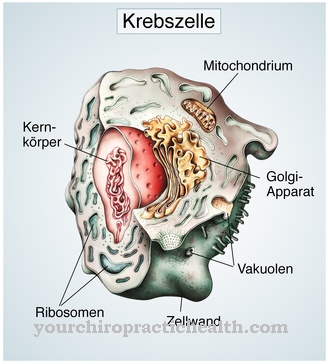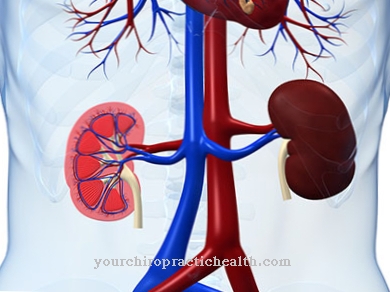The Onchocerciasis - or River blindness - is a parasitic disease caused by the filariae worm Onchocerca volvulus. River blindness is one of the most common infectious causes of blindness in the world.
What is river blindness?
.jpg)
© sek1111 - stock.adobe.com
River blindness is a massive health problem in over 99% of all cases in sub-Saharan Africa, but it is also known in Yemen and Latin America.
In the past, fear of river blindness caused many people to abandon the fertile river valleys of the African savannah. An estimated 18 million people are infected with river blindness, and around half a million people are blind or visually impaired by the disease.
River blindness also triggers skin changes with depigmentation and severe, relentless itching. Untreated infection with river blindness reduces the host's immunity and resistance to other diseases, as a result of which lifespan is shortened by approximately 13 years.
causes
The nematode that causes river blindness is transmitted by the bite of infected female Simulium black flies that live in fast-flowing streams and rivers.
The parasite is first ingested by an infected human host and matures into larvae in the black fly for about 7 days. If there is another bite, the larva is transferred to the blood of the next host. There the larvae penetrate the subcutaneous tissue, mature for six to twelve months and can live as worms in the human body for up to 15 years.
In the adult stage, the worms mate and produce more microfilariae, which form nodules under the skin. Dying microfilariae release the Wolbachia bacterium. This causes intense inflammatory reactions that trigger a reaction of the immune system (river blindness).
Symptoms, ailments & signs
River blindness (onchocerciasis) is characterized by a large number of symptoms, which are mainly determined by the strength of the reaction of the immune system to the microfilariae.
Typical symptoms are itching of the skin, skin inflammation, eczema formation, swelling of the lymph nodes in the groin region, changes in skin pigmentation, skin thickening due to skin fiber damage, skin abscesses, vascular inflammation, development of palpable skin nodules and eye problems.
The eye problems in particular give the disease its name, because in severe cases it can lead to complete blindness. When the roundworms migrate into the eyes, the entire organ of vision is damaged there. The eye symptoms range from conjunctivitis to glaucoma.
This leads to eye inflammation, itchy eyes, tears and burning. Those affected have the feeling that there is sand in their eyes. Similar symptoms are also described for inflammation of the choroid. However, this can increase intraocular pressure and cause glaucoma. Since the optic nerve is damaged by the high intraocular pressure, glaucoma (glaucoma) can lead to complete blindness.
The cornea is also damaged. This initially results in punctiform corneal defects, which can later expand into corneal opacity with a loss of vision. Here, too, pain, red eyes, increased tearing and sensitivity to light occur initially. Optic nerve inflammation is also less common. Without treatment for river blindness, the susceptibility to infection generally increases with a decrease in life expectancy.
Diagnosis & course
Skin patch tests are used to confirm the diagnosis because river blindness causes different types of skin changes. The severity of the disease is directly proportional to the number of infected microfilariae and the resulting immune response.
In the most common cases of river blindness, skin inflammation occurs accompanied by hyperpigmentation (microfilariae excreted through the skin) and severe itching. Other characteristic skin symptoms of river blindness are "leopard skin" (depigmentation on the lower legs), "elephant skin" (thickening of the skin) or "lizard skin" (thickened, wrinkled skin).
People with river blindness may have several hundred nodules on their skin, one to five centimeters in size, that are usually not painful. River blindness can also affect any part of the eye from the conjunctiva to the cornea, including the retina and the optic nerve, and cause visual disturbances up to blindness.
Complications
The main complications of river blindness are that the disease only becomes noticeable and leads to symptoms about six months after infection. This usually results in swelling of the lymph nodes and a rash. The rash is often very itchy and very uncomfortable.
This restricts the patient's everyday life. The person affected also suffers from lumps that settle in different parts of the body. The affected areas dry out and itch. As a rule, the knots lead to a strong feeling of shame. Complications can also arise if the worms enter the eye and inflame the optic nerve. This leads to severe pain and clouding of the lens.
In the worst case, the patient can go completely blind or suffer from glaucoma. If river blindness is not treated, the immune system will also be severely damaged and the patient will be more susceptible to various immune diseases. Treatment of river blindness is usually done with the help of medication and in most cases leads to a positive course of the disease. If the worms are near the eyes, a surgical procedure is necessary.
When should you see a doctor?
In case of river blindness, a doctor must always be consulted immediately. In the worst case, this disease can lead to complete blindness of the person concerned and should therefore always be treated immediately. People must see a doctor if they have been bitten by a mosquito in a tropical region and experience symptoms of river blindness. This includes a very itchy rash on the skin and swelling of the lymph nodes.
General tiredness and exhaustion can also indicate the disease. Furthermore, river blindness leads to unusual pigmentation on the skin and also to lumps that form near joints. In the further course of the disease, the eyes are also damaged, leading to visual problems or conjunctivitis.
Immediate treatment is necessary for these complaints. Treatment can usually be carried out by a general practitioner or in a hospital. The earlier the disease is diagnosed, the better the chances of a positive course of the disease. Good hygiene can also prevent river blindness.
Doctors & therapists in your area
Treatment & Therapy
Ivermectin (e.g. Mectizan®) is mainly used to treat river blindness. It paralyzes and kills the microfilariae, reduces the intense itching, and stops the progression of river blindness to prevent blindness.
At the same time, by paralyzing the parasitic reproductive organs, it prevents the further production of microfilariae for several months and thus reduces the transmission rate of river blindness. Infected people can be treated with two doses of ivermectin given 6 months apart. Thereafter, a single dose of ivermectin must be taken annually for 3 years to maintain effectiveness.
For best results, WHO recommends treating entire communities at the same time. Since the ultimate hosts of river blindness are humans, animals do not need to be treated. Other drugs used to treat river blindness are used to kill the Wolbachia bacterium, which lives in symbiosis with the worms, and to sterilize the female roundworms.
In addition to the antiparasitic drug moxidectin, this also includes the tetracycline antibiotic doxycycline. However, this additional therapy for river blindness requires daily dosing for at least four to six weeks, which is difficult to achieve in crisis areas.
Outlook & forecast
The prognosis of river blindness depends on the number of pathogens present in the organism and the disorders that have already occurred. A particular difficulty lies in the point in time at which the diagnosis is made. By the time the impairment is consciously perceived, the parasite causing the disease has been in the person's body for about six months to three years.
Since the roundworm occurs mainly in Africa and Latin America, residents and travelers from these areas are particularly at risk. Due to the long incubation period, tourists or guests of the regions often lack the connection and connection between the symptoms and their stay in the tropical region. This makes an early diagnosis difficult and often delays the start of treatment. If there is no medical therapy, the patient is at risk of complete blindness.
With good and efficient medical care, onchocerciasis is easily treatable and curable. The existing symptoms recede and the general state of health gradually improves. The patients can be discharged as symptom-free after the end of the drug treatment. Since the disease is being systematically combated worldwide by the WHO, a decline in the infestation of river blindness and faster and better treatment can be expected in the coming years.
prevention
Through the vector-based use of environmentally friendly insecticides on rivers to control black flies populations, the WHO has been taking preventive measures to contain the black flies for more than 40 years River blindness around. For the treatment of river blindness, the manufacturer of ivermectin - Merck & Co. Inc. - has provided the drug free of charge since 1987.
Aftercare
As a rule, the measures and possibilities of follow-up care for onchocerciasis prove to be very difficult or are hardly possible. First and foremost, of course, contact with the infected water should be interrupted so that there is no renewed infection or transmission. In general, a high standard of hygiene should also be observed in order to prevent infections and to treat onchocerciasis properly.
Onchocerciasis is treated in most cases with the help of drugs that can completely alleviate the symptoms. There are seldom any particular complications. The person concerned is dependent on regular and correct intake of the medication in order to completely relieve the symptoms. Attention should also be paid to the correct dosage.
If you have any questions or are unclear, you should always consult a doctor. In most cases, the medication will need to be taken for a while after the symptoms have subsided. Self-healing cannot occur with this disease. If the onchocerciasis is recognized and treated early, there is usually no reduction in the life expectancy of the person affected.
You can do that yourself
River blindness must always be treated by a doctor. Opportunities for self-help are very limited with this disease, so that the person affected is primarily dependent on drug treatment.
As a rule, the drug must be taken for almost three years. In doing so, attention should be paid to interactions with other drugs in order not to reduce the effect of the substance. River blindness can, however, be prevented by using insecticides in rivers. Good hygiene can also prevent infection.
If the river blindness is not treated, the patient can become completely blind. In this case, the person concerned is then dependent on support in his everyday life. This should mainly be done by family or friends. In serious cases, those affected are also dependent on psychological treatment. Discussions with other affected patients are often very helpful in order to cope with everyday life.
In order to guarantee a positive course of the disease in river blindness, immediate treatment should be initiated. In doing so, further complications can be avoided, which in the worst case can lead to blindness.




.jpg)
.jpg)


















.jpg)



